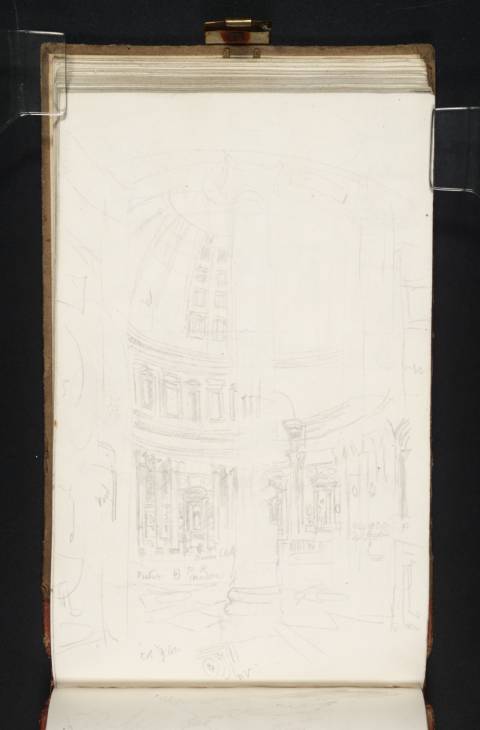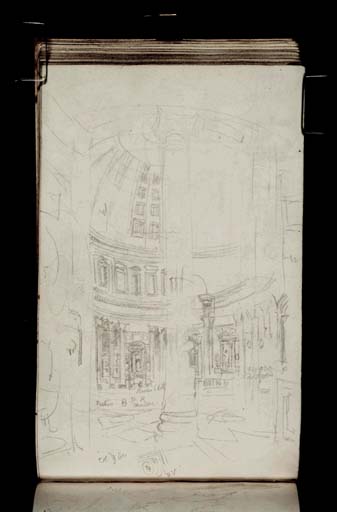Joseph Mallord William Turner Interior of the Pantheon, Rome 1819
Image 1 of 2
Joseph Mallord William Turner,
Interior of the Pantheon, Rome
1819
Joseph Mallord William Turner 1775–1851
Folio 65 Verso:
Interior of the Pantheon, Rome 1819
D16273
Turner Bequest CLXXXVIII 64 a
Turner Bequest CLXXXVIII 64 a
Pencil on white wove paper, 189 x 114 mm
Inscribed by the artist in pencil ‘W’ within left-hand side of dome and ‘red’ on left-hand column, ‘W’ on centre far right-hand side and ‘90 P’ and ‘P’ bottom far right-hand side. Also ‘Pictures’ and ‘Scarlet Cloth | P P | Madona’ on floor of Pantheon to left of central column and ‘XIIIIvi’ to right of central column. Also ‘col of [?Gr] and ‘WV’ centre bottom
Accepted by the nation as part of the Turner Bequest 1856
References
1909
A.J. Finberg, A Complete Inventory of the Drawings of the Turner Bequest, London 1909, vol.I, p.560, as ‘Interior of the Pantheon’.
1984
Cecilia Powell, ‘Turner on Classic Ground: His Visits to Central and Southern Italy and Related Paintings and Drawings’, unpublished Ph.D thesis, Courtauld Institute of Art, University of London 1984, p.115, reproduced fig.55, as ‘The Pantheon’.
The Pantheon is the oldest surviving domed structure in Rome and one of the city’s most famous buildings. Once an ancient temple, it was later consecrated as a Christian church, an event which helped to ensure its preservation. In addition to its architectural significance, the building houses some notable tombs, including those of painters Annibale Carraci and Raphael. The interior had long been a popular subject for artists since, unlike cruciform churches, the entire sense of the circular building could be expressed within a single view.1 Turner’s viewpoint for this sketch is one of the six side apses encircling the perimeter and his view is bisected by one of two huge granite columns.2 He has recorded the decorative scheme of the interior at every level from floor to ceiling, including the patterning of the marble floor, the niches containing statues spaced at intervals between the apses, the false windows within the frieze below the dome, the coffered ceiling and the oculus in the centre at the top, the only source of light for the building. The choice of another angle would only have yielded a similar view and the wealth of detail included here rendered further study of the interior unnecessary.
For a general discussion and other sketches of the Pantheon see folio 29 (D16208; Turner Bequest CLXXXVIII 28).
Nicola Moorby
January 2009
For example Giovanni Battista Piranesi (1720–1778), etchings from Le Antichità Romane I, 1756 and Veduta di Roma, published 1778, see Luigi Ficacci, Piranesi: The Complete Etchings, Köln and London 2000, nos.163 reproduced p.184 and 957 reproduced p.733; Giovanni Paolo Panini (1691/2–1765), Interior of the Pantheon, pen and ink and watercolour on paper (Courtauld Institute of Art Gallery, London), and Heneage Finch (1786–1859), Interior of the Pantheon, Rome, watercolour (Tate, T09835).
How to cite
Nicola Moorby, ‘Interior of the Pantheon, Rome 1819 by Joseph Mallord William Turner’, catalogue entry, January 2009, in David Blayney Brown (ed.), J.M.W. Turner: Sketchbooks, Drawings and Watercolours, Tate Research Publication, December 2012, https://www


